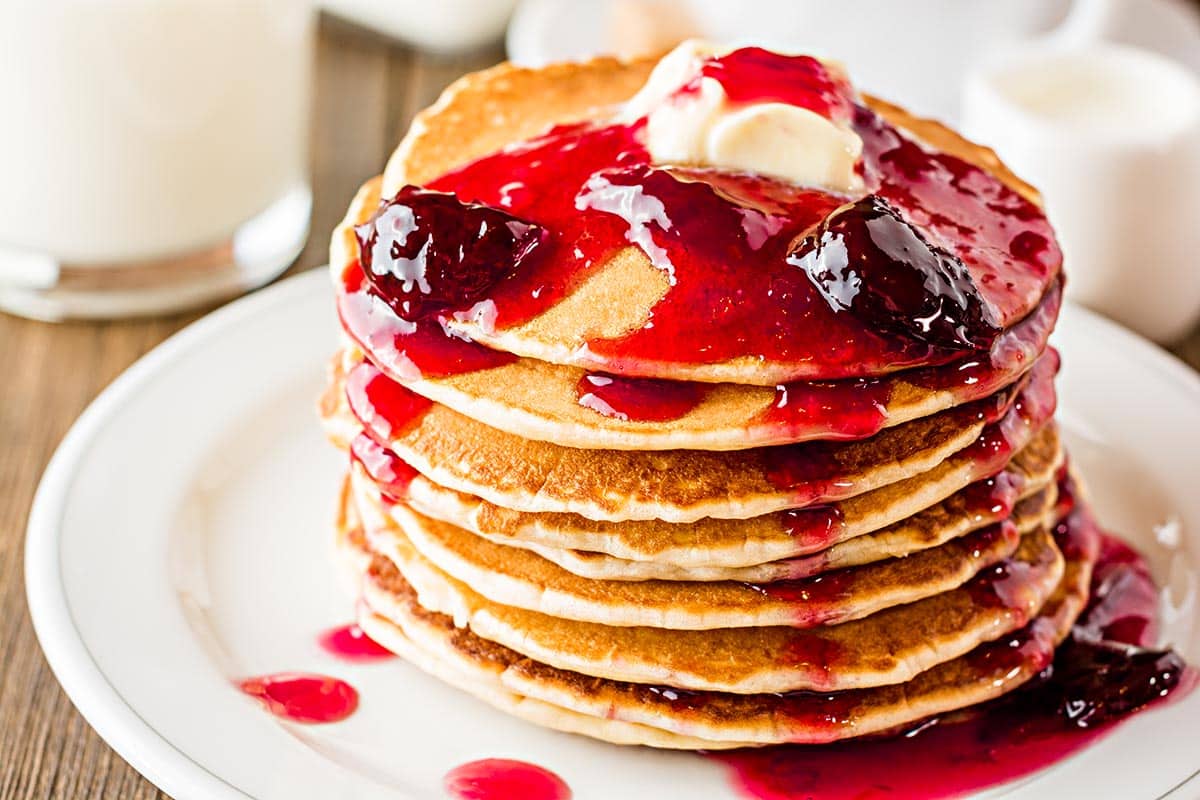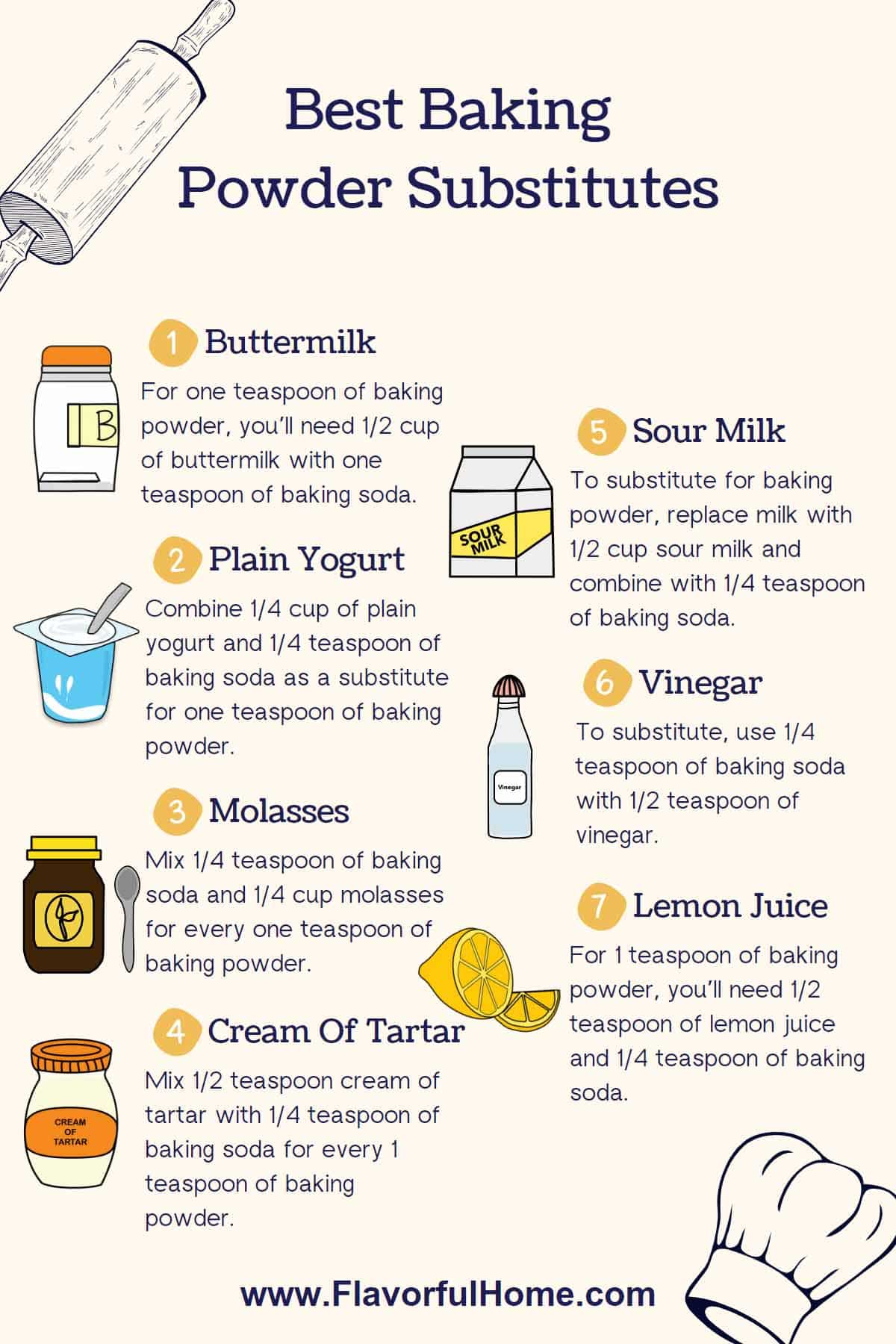Every baker, beginner or pro, knows how crucial baking powder is. So we understand how frustrating it is to not have one in your pantry. The good news is you can easily find a substitute for baking powder in pancakes.
Let’s brush up on some baking knowledge and see why this ingredient is so important.

Baking powder is a leavening agent that helps cake batters and doughs rise. Not only that, but it can also help lighten and add volume to pancake batters.
This dry ingredient is a mixture of carbonate or bicarbonate and a weak acid. A buffer, usually cornstarch, is also added to the mix. The buffer prevents the acid and base from reacting with each other prematurely.
Before baking powder was invented, cooks used other rising agents. Yeast was the go-to leavener for breads. But yeast was unpredictable back then and left a bitter taste. For cakes, bakers would use beaten egg whites. But achieving the right consistency took time and effort.
It wasn’t until the 1790s that pearlash came into use. It was thanks to Native Americans who found a way to use the purified form of potash. Potash had the same leavening effect as yeast but was faster and easier to use. It was also the ingredient that paved the way for modern-day baking powder.
Baking powder is a dry chemical leavening agent. It consists of baking soda, a dry acid, usually cream of tartar, and cornstarch. But why is baking powder essential in baking?
Understanding how baking powder works starts with knowing what baking soda is.
Baking soda, also known as sodium bicarbonate, is a base. When bicarbonate comes in contact with an acid, it creates an acid-base reaction. The mixture releases carbon dioxide gas.
Any type of acid, like lemon juice and vinegar, can activate baking soda. The release of carbon dioxide gas creates air bubbles. This reaction causes baked goods like bread, cookies, and cakes to rise. This reaction is also the key to achieving fluffy pancakes.
The difference between baking powder and baking soda lies in their chemical properties.
Baking soda is simply sodium bicarbonate. Meanwhile, baking powder contains bicarbonate and a dry acid.
That said, baking soda alone can still act as a leavening agent unless paired with an acid. The mixture will still release the same chemical reaction when exposed to heat. But, it may impart a bitter or metallic taste to your dish.
Like many baked goods, fluffy pancakes don’t happen naturally. They need an extra lift to achieve that texture.
Most pancake recipes use baking powder, but what if you have none? Luckily, there are many excellent baking powder substitutes available.
Here’s a list of the best baking powder substitutes to use in your pancake batter:
Buttermilk is a fermented dairy product with a sour taste, like plain yogurt. Traditional buttermilk is a leftover product from churning sweet cream into butter. Compared to other liquids, buttermilk is an acidic ingredient. When paired with baking soda, it will have the same leavening effect.
Buttermilk is also one of the best baking powder substitutes.
When using buttermilk, remember to reduce the measurement of other liquids. This helps maintain the desired consistency.
Pro Tip.
For one teaspoon of baking powder, you’ll need 1/2 cup of buttermilk with one teaspoon of baking soda.
Plain yogurt is one of the most accessible baking powder substitutes. It’s made from fermented milk and contains lactic acid. Since it has an acidic pH, plain yogurt perfectly pairs with baking soda.
Another alternative to plain yogurt is sour cream. This is another fermented dairy product. It’s also an acidic ingredient that can activate baking powder’s leavening effect.
Pro Tip.
Combine 1/4 cup of plain yogurt and 1/4 teaspoon of baking soda as a substitute for one teaspoon of baking powder. We recommend using plain yogurts as flavored ones have many additives.
Molasses is another excellent baking powder substitute. It’s a byproduct of sugar production and a popular sweetener. Molasses is also an acidic ingredient that you can pair with baking soda.
Molasses also imparts flavor without overwhelming the final dish.
Pro Tip.
Mix 1/4 teaspoon of baking soda and 1/4 cup molasses for every one teaspoon of baking powder. Since molasses is already sweet, we recommend cutting the sugar in your recipe by half.
Cream of tartar is an acidic white powder that acts as the dry acid in commercial baking powders. Cream of tartar is also used as a baking powder substitute. Cream of tartar is available in supermarkets and often spotted in the spice aisles.
Pro Tip.
Mix 1/2 teaspoon cream of tartar with 1/4 teaspoon of baking soda for every 1 teaspoon of baking powder.
You can also use sour milk as a substitute for baking powder. Sour milk is basically milk allowed to sour using an acid. Since it’s acidic, sour milk reacts with baking soda to achieve a leavening effect.
To make sour milk, mix 1 cup of milk and 1 tablespoon of white vinegar or lemon juice.
Pro Tip.
To substitute for baking powder, replace milk with 1/2 cup sour milk and combine with 1/4 teaspoon of baking soda.
Vinegar is also an excellent substitute for baking powder if you’re in a pinch. This ingredient comes from alcohol turned into acetic acid by bacteria. Surprisingly, vinegar is popular among recipes for baked goods.
When replacing baking powder, use plain vinegar or apple cider vinegar. Although it has a strong flavor, your recipe will still have a neutral taste.
Pro Tip.
To substitute, use 1/4 teaspoon of baking soda with 1/2 teaspoon of vinegar.
Lemon juice is one of the best acids you can pair with baking soda. Lemon juice has high citric acid content that can produce the same leavening effect. But it does have an intense flavor, so you may want to use it sparingly.
If you don’t have lemons, you can also use lime or calamansi.
Pro Tip.
For 1 teaspoon of baking powder, you’ll need 1/2 teaspoon lemon juice and 1/4 teaspoon of baking soda.
Club soda is a carbonated drink made from water and baking soda. If you don’t have baking powder or baking soda, you can use club soda as a substitute.
But take note that it doesn’t have a lot of sodium bicarbonate. Only use club soda for recipes that need small lifts, like pancakes.
You can also use club soda when replacing milk in baked goods.
When using club soda as a substitute, remember to adjust the other liquids. This is especially true for pancake batters that require a certain consistency.
Pro Tip.
Mix 1 cup of water with 1 teaspoon of baking soda, and you’ll have your own club soda.
If you’re out of options, you can use self-raising flour, also known as self-rising flour. Unlike regular flour, this version consists of all-purpose flour and baking powder. It’s often used in baked goods or ready-made mixes for cakes and pancakes.
Pro Tip.
To substitute, use the self-rising flour according to package instructions. Don’t forget to remove baking powder or baking soda from the recipe. Self-rising flour already contains both.
Whipped egg whites are also an excellent baking powder substitute for pancakes. This comes as no surprise since whipped egg whites are a main ingredient in meringues and cakes. In fact, you can’t make the extra fluffy Japanese soufflé pancakes without this ingredient.
To make whipped egg whites, separate the yolks from the egg whites. In a bowl, beat the egg whites at a low and consistent speed until they form soft peaks. The soft peaks create air bubbles inside the batter, giving the recipe an extra lift.
You can add refined sugar to infuse more flavor when using whipped egg whites.
Pro Tip.
It’s important to note that different baked goods need varying measurements. For example, pancakes need at least 3 egg whites, while an angel food cake recipe will need 12 egg whites.

There are many substitutes for baking powder, but how do you know which is best for your recipe?
The main consideration is flavor. Baked goods are delicate, so be sure to choose a substitute with the same neutral taste as baking powder.
Baking powder is a common ingredient in many baked goods recipes.
The general rule of thumb is to use a teaspoon of baking powder per cup of regular flour. Baking soda is typically used in recipes that don’t need an acidic ingredient.
For example, a chocolate chip cookie recipe will have chewy and sweet flavors. If you’re using baking soda, you’ll need to add an acid like vinegar or lemon juice. But these liquids have a strong flavor and may affect the overall taste of the dessert.
There are two types of baking powder. These are double-acting baking powder and single-acting baking powder. Commercial baking powder is often sold as the double-acting type. But how do the two types differ?
As its name suggests, double-acting baking powder has two reactions. The first reaction or rise occurs when the soda comes into contact with other liquids. The second rise happens when you apply heat to the baking powder. Meanwhile, single-acting baking powder only rises during heat application.
Some recipes also call for both baking powder and baking soda. This usually happens if the product needs an extra lift. Other reasons include adding tangy flavors and getting a better browning on crusts.
Even though baking powder is a dry ingredient, it can still go bad. Baking powder loses its potency over time, especially if not stored correctly.
Always keep the baking powder in an airtight container inside your pantry. You should also keep it away from moisture or direct sunlight.
Your baking powder is good to use if it hasn’t reached its expiration date.
You can always test your baking powder if you’re unsure about it.
To do this, place a tablespoon of baking powder in hot water. The mixture should create tons of bubbles. But if little to no bubbles form, the baking powder is no longer active.
The main difference between the two is that the former already includes a dry acid, often a cream of tartar. When using baking soda, you still need to add an acidic ingredient to create a reaction.
Yes, you can make pancakes without baking powder. You can use buttermilk, egg whites, or plain yogurt.
Yes, you can mix baking soda and buttermilk together. This mixture is the best baking powder substitute for pancakes.

Baking powder is a leavening agent commonly used in baked goods. It creates the lift needed in cakes, bread, or pancake recipes. Without baking powder, breads, and pastries will remain flat.
If you don’t have baking powder, there are many handy alternatives. One of the best substitutes is buttermilk. It’s a natural acidic ingredient that you can pair with baking soda. Other kitchen substitutes include vinegar, lemon juice, or egg whites.
The easiest way to substitute baking powder is to use self-rising flour. And if you’re out of options, you can always make your own baking powder.
When replacing baking powder, consider the final flavor. The substitute shouldn’t affect the overall taste of the recipe and still give it the extra lift.





